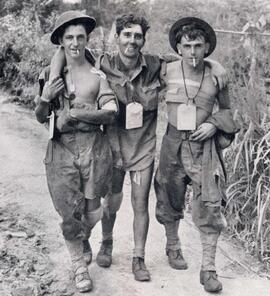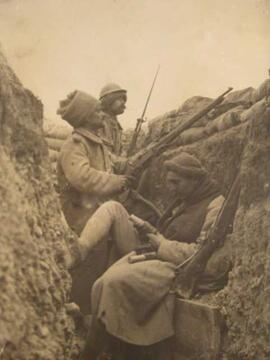BRITISH ARMY FIELD MANUALS, 1963-2004
- BRITISH ARMY FIELD MANUALS
- Collection
- 1963-2004
British Army publications, 1963-2004. Volumes of the Army Field Manual including: 'The Armoured Division in Battle' (1990); 'Infantry Operations' (1990); 'Combat Service Support' (1992); 'Background to the Soviet Army' (1986); 'A Treatise on Soviet Operational Art' (1991); 'Soviet Tactics' (1991); 'Generic Enemy (Basic Forces): Operational Art' (1995); 'Operations in Specific Environments: Urban Operations' (1999); 'Battlegroup Tactics' (1990); 'The Infantry Battalion in Battle' (1990); 'Operations within the UK: Military Home Defence' (1990); 'Fighting in Built-up Areas' (1983); 'Chemical Operations' (1990); 'Cold Climate Operations' (1992); 'All Arms Tactics in Special Environments: Desert' (1995); 'Operations Other than War: Counter Insurgency Operations' (1995), 'Peacekeeping Operations' (1988) and 'Wider Peacekeeping' (1994); 'Combined Arms Operations: Formation Tactics' (1995 and 2002 Dec editions), 'Battlegroup Tactics' (1998 and 2002 Feb editions), 'Intelligence, Surveillance, Target Acquisition and Reconnaissance (ISTAR)' (2002 Mar), 'Countersurveillance, Opsec [operations security] and Deception' (1999 Oct), 'Operations in Nuclear, Biological and Chemical (NBC) Conditions' (2002 Oct), 'Training for Operations' (1997), 'Command and Staff Procedures' (1999 and 2002 editions) and 'Tactical Guidance for Operations Other than War' (2000).Tactical and Doctrinal publications including: 'Keeping the Peace: Doctrine' (1963 Jan); 'Tactical Doctrine and Arms Directorate: The Army Tactical Doctrine Handbook' (1985) and 'Tactical Aide Memoire' (1988); 'Joint Warfare Publication: British Defence Doctrine' (1996); 'Design for Military Operations: the British Military Doctrine' (1996); 'Army Doctrine Handbook' (2000 Jul); 'Land Component Handbook: doctrinal notes' (2004 Nov); 'Army Doctrine Publications: Command' (1995 Apr), 'Logistics' (1996 Jun and 2000 Apr editions), 'Training' (1996 Dec), and 'Soldiering - the Military Covenant' (2000 Feb).Land Operations manuals including: 'The Fundamentals Part 1: the application of force', 'Part 2: command and control', 'Part 3: the combat arms' and 'Part 4: fire support' (1968 -1977); 'Non Nuclear Operations Part 1: formation tactics', 'Part 2: battle group tactics', 'Part 3: combat team tactics in mechanised operations', 'Part 4: crossing and breaching obstacles' and 'Part 5: air defence of the field army' (1971-1977); 'Counter-Revolutionary Operations Part 1: general principles', 'Part 2: procedures and techniques', 'Part 2: internal security' (1969 version) and 'Part 3: counter insurgency' (1969-1977); 'Nuclear Operations Part 1: nuclear fire power' and 'Part 2: tactics' (1970-1971); 'Operational Techniques Under Special Conditions Part 1: mountainous country', 'Part 2: jungle', 'Part 3: desert', 'Part 4: cold climate' (1972-1979).Standing Operating Procedures (SOPs) including: 'Army Formation Standing Operating Procedures (AFSOPs)' (1989); 'UK Land Forces: Formation Standing Operating Procedures' (1989 Jul); '1 British Corps: Standing Operating Procedures' (1991 Jan) and 'Land Component Handbook (Formation SOPs)' (2000 Sept).Handbooks, guidebooks and manuals including: 'Administration in the Field' (MOD, 1975); 'Umpiring the Effects of Artillery Fire: A Guide for Umpires of All Arms' (1981); 'Administration in War', (MOD, 1984); 'Medical Interoperability Handbook' (German/English version) (1986 Feb); 'Data Protection Act 1984: A Guide to the Act' (MOD, 1987 Aug); 'Manual of Nuclear, Biological and Chemical Defence Training on Land' (1988); 'Staff Officers Handbook' (1988); 'Unit Guide to the Administration of Personnel in War' (1989); 'Instructions for the Handling of Prisoners of War' (MOD, 1990); 'The Manual of Joint Warfare Volume VIII (JSP 7): Military Psychological Operations' (1992); 'Unit Battlefield Countersurveillance' (1994 Jun); 'Generic Enemy (Genforce) Handbook: Rest of the World Enemy (ROWEN)' (1995); 'Military Aid to the Civil Community in the United Kingdom' (1997); 'Generic Enemy (Genforce) Handbook: Mobile Forces' (1997); 'Staff Officers' Handbook' (2000 Jul); 'ABCA: Coalition Logistics Handbook' (Quadripartite Advisory Publication, 2003 Jun).Training guides including: 'Training for War: the Principles and Organisation of Training, Individual Training, Collective Training and Territorial Army' (1981).Publications by other military forces including: 'On Point: The United States Army in Operation Iraqi Freedom', by Col G Fontenot, LTC EJ Degen and LTC D Tohn (Fort Leavenworth, Kansas: Combat Studies Institute Press, 2004); Royal Netherlands Army Doctrine Publications: 'Military Doctrine' (1996), 'Combat Operations Against an Irregular Force' (2003), and 'Peace Operations' (1999).



